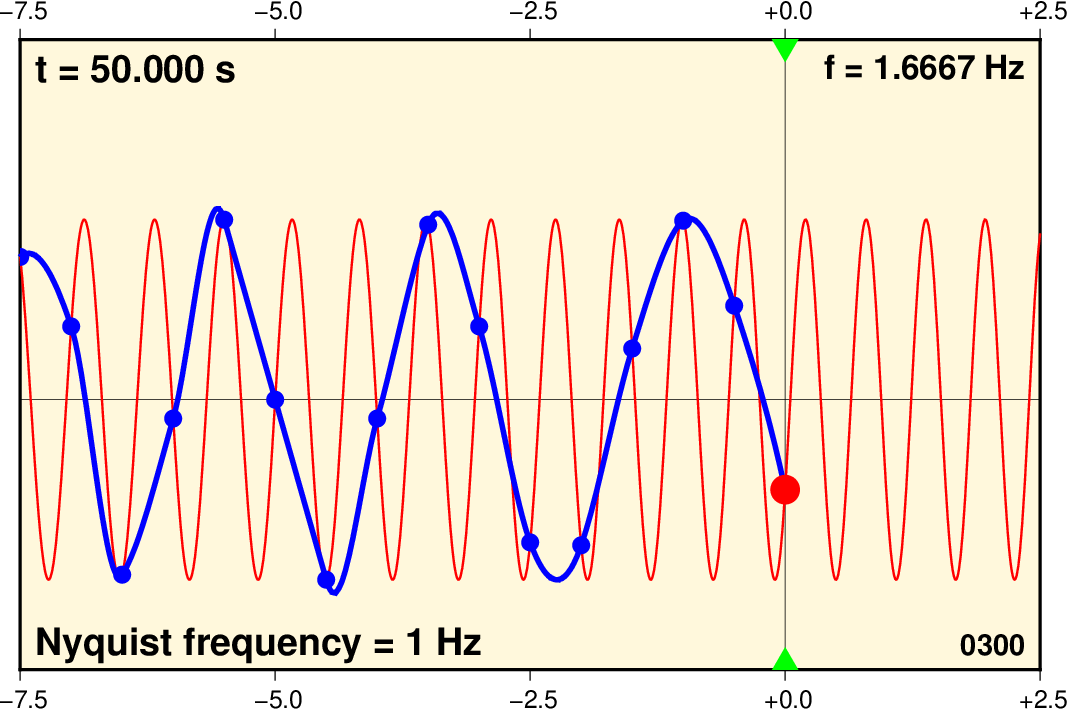(6) Demonstrate aliasing by sampling a chirp¶
We demonstrate how aliasing works by sampling a chirp at a fixed interval of 0.5 seconds. We try to reconstruct the signal by using a cubic spline on the sampled values. This works well for at the start but once we approach the Nyquist frequency it breaks down badly.
#!/usr/bin/env bash
# GMT ANIMATION 06
#
# Purpose: Demonstrate aliasing by sampling a chirp
# GMT modules: math, convert, basemap, plot, text, movie, sample1d
# Unix progs: echo, cat
# Note: Run with any argument to build movie; otherwise 300th frame is plotted only.
if [ $# -eq 0 ]; then # Just make master PostScript frame 300
opt="-M300,ps -Fnone"
ps=anim06.ps
else # Make movie in MP4 format and a thumbnail animated GIF using every 10th frame
opt="-Fmp4 -A+l+s5"
fi
rate=6 # Frames per seconds
frames=`gmt math -Q 60 $rate MUL =`
# 0. Initial parameters
cat << EOF > init.sh
R=-R-7.5/2.5/-1.5/2 # Fixed plot domain window
J=-JX6.8i/4.2i # Frame size after removing margin space
f=2 # Frequency of chirp in Hz at end time
rate=$rate
frames=$frames
EOF
# 1. Create background plot and data files needed in the loop
cat << EOF > pre.sh
gmt begin
gmt basemap \$R \$J -X0.2i -Y0.3i -Bxa2.5g10 -By0g10 -B+gcornsilk --FORMAT_FLOAT_MAP=%+5.1f
cat <<- END | gmt plot -S0.3i -Ggreen
0 -1.5 t
0 +2.0 i
END
# Add Nyquist frequency in lower left corner
echo "-7.5 -1.5 Nyquist frequency = 1 Hz" | gmt text -F+f18p,Helvetica-Bold+jBL -Dj0.1i/0.1i
gmt end
# Build chirp data sets for 1 minute (60 secs); one every 1 ms and one every 0.5 sec as samples
gmt math -T0/60/0.001 T 2 POW 2 DIV 60 DIV \$f MUL 2 MUL PI MUL COS = chirp.txt
gmt math -T0/60/0.5 -Ca T -C1 2 POW 2 DIV 60 DIV \$f MUL 2 MUL PI MUL COS = chirp_samples.txt
gmt math -T0/\$frames/1 T \$rate DIV = frame_times.txt
EOF
# 2. Set up the main frame script
cat << EOF > main.sh
gmt begin
# Shift the chirp in time to simulate paper movement
gmt math chirp.txt -C0 \${MOVIE_COL1} SUB = chirp_shifted.txt
# Plot the shifted chirp
gmt plot \$R \$J chirp_shifted.txt -W1p,red -X0.2i -Y0.3i
# Compute index of most recent sample number
last_sample=\`gmt math -Q \${MOVIE_FRAME} \$rate 2 DIV DIV FLOOR RINT =\`
# Extract all the old samples before the present
gmt convert chirp_samples.txt -Z:\$last_sample > tmp.txt
if [ -s tmp.txt ]; then
gmt math tmp.txt -C0 \${MOVIE_COL1} SUB = samples.txt
gmt plot -Sc0.3c -Gblue samples.txt
fi
# Take a new sample every 12 frames = 0.5 seconds
take_sample=\`gmt math -Q \${MOVIE_FRAME} \$rate 2 DIV MOD 0 EQ =\`
if [ \${MOVIE_FRAME} -gt 12 ]; then # Interpolating up to most recent sample
gmt sample1d samples.txt -I0.001 > resampled.txt
gmt plot -W2.5p,blue resampled.txt
fi
if [ \$take_sample -eq 1 ]; then # Take and plot sample at zero time
y=\`gmt math -Q \${MOVIE_COL1} 2 POW 2 DIV 60 DIV \$f MUL 2 MUL PI MUL COS =\`
echo 0 \$y | gmt plot -Sc0.5c -Gred
fi
# Add time counter in upper left corner
printf "%4.1f 2 t = %6.3f s\n" -7.5 \${MOVIE_COL1} | gmt text -F+f18p,Helvetica-Bold+jTL -Dj0.1i/0.1i
# Add cycles counter in upper right corner
fnow=\`gmt math -Q \${MOVIE_COL1} 60 DIV \$f MUL =\`
printf "2.5 2 f = %6.4f Hz\n" \$fnow | gmt text -F+f16p,Helvetica-Bold+jTR -Dj0.1i/0.1i
# Add frame counter in lower right corner
printf "2.5 -1.5 %04d\n" \${MOVIE_FRAME} | gmt text -F+f14p,Helvetica-Bold+jBR -Dj0.1i/0.1i
gmt end
EOF
# 3. Run the movie
gmt movie main.sh -Sbpre.sh -C7.2ix4.8ix100 -Iinit.sh -Tframe_times.txt -D$rate -Nanim06 -Z $opt
rm -rf init.sh main.sh pre.sh

Demonstrate aliasing by sampling a chirp.